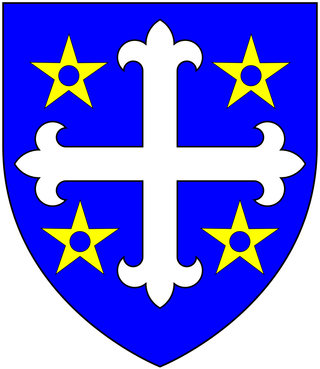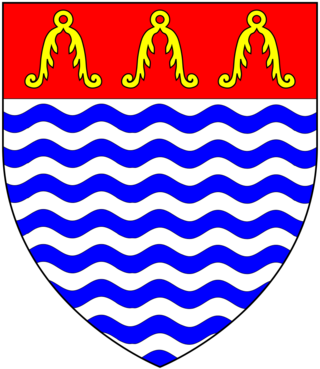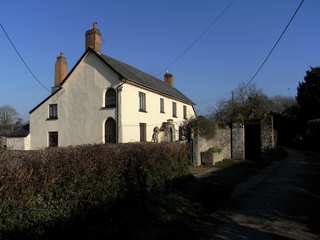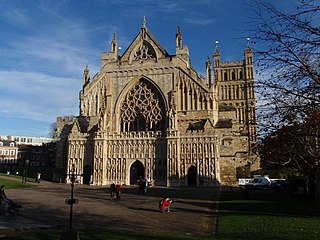

William Cotton (died 1621) was Bishop of Exeter, in Devon, from 1598 to his death in 1621.


William Cotton (died 1621) was Bishop of Exeter, in Devon, from 1598 to his death in 1621.
William Cotton was brought up in Finchley, Middlesex. [1] He was the eldest son of John Cotton, a Citizen of the City of London by his wife Pery Cheyne. John Cotton was the third son of Richard Cotton (died 1534) of Hamstall Ridware in Staffordshire, descended from William Cotton (fl.1378,1400) lord of the manor of Cotton in Cheshire, by his wife Agnes de Ridware, daughter and heiress of Walter de Ridware, lord of the manor of Hamstall Ridware. [2] The junior branch of the Cotton family descended from Agnes de Ridware adopted the armorials of Ridware (Azure, an eagle displayed argent) [3] in lieu of their paternal arms of Cotton, which junior branch included Sir Robert Cotton, 1st Baronet (1570–1631) of Conington in Huntingdonshire, founder of the Cottonian Library. The senior branch, of which Bishop Cotton was a member, retained the ancient arms of Cotton (Argent, a bend sable between three pellets ), as is visible on the monuments in Exeter Cathedral to Bishop William Cotton himself and on that of his grandson Edward Cotton (died 1675), Treasurer of Exeter Cathedral. [4]
He graduated M.A. at Queens' College, Cambridge in 1575. [5] He was Archdeacon of Lewes, in Sussex, from 1578 to 1598, when he became Bishop of Exeter. [6]
He was confrontational in his relationship with the Puritans of his diocese. He objected strongly to the nomination of John Hazard as Bodley lecturer. [7] Cotton suspected Hazard of "false doctrine", of intrusion into congregations that already had preachers, and association with John Traske, the seventh-day Sabbatarian, which Hazard denied. George Abbot, Archbishop of Canterbury, had licensed Hazard to preach, but Cotton was not satisfied with that. [8] [9]
Cotton is credited with ordering the oldest documented extant cat flap, with a payment of eight pence made to carpenters at Exeter Cathedral to cut a hole in a door to enable his cat to hunt for rodents. [10]
He married Mary Hulme, a daughter of Thomas Hulme of Cheshire and widow of William Cutler, a Citizen of the City of London. [11] By his wife he had children as follows:
He died on 6 August 1621 and was buried in Exeter Cathedral where his fine monument with recumbent effigy survives.

The Cary family is an English aristocratic family with a branch in Ireland. The earliest known ancestor of the family is Sir Adam de Kari who was living in 1198. Sir John Cary purchased the Manor of Clovelly in the 14th century and established the family's status as members of the landed gentry. Various branches of the family were ennobled in the late 16th and early 17th centuries as Baron Hunsdon and Viscount Falkland.
Richard Stephen Hawkins is a bishop in the Church of England and currently a chapter canon of Exeter Cathedral.

Elize Hele (1560–1635) of Fardel in the parish of Cornwood, Devon and of Parke in the parish of Bovey Tracey, Devon, was an English lawyer and philanthropist. In 1632 he transferred his lands into a trust intended for "pious uses", from which charitable action and in order to distinguish him from his many prominent relations, he became known to posterity as "Pious Uses Hele", which his biographer Prince looked upon "as a more honourable appellation than the greatest empty title". The trustees included his wife, together with John Hele and a number of friends. The trust was used to create a number of schools in Devon including Plympton Grammar School.

Valentine Cary, was an English clergyman, who became Bishop of Exeter.

William Helyar of Coker Court, East Coker, in Somerset, was Archdeacon of Barnstaple and a chaplain to Queen Elizabeth I.
Henry Squire was an English poet and clergyman, and Archdeacon of Barnstaple from 1554 to 1582.

Doctor George Cary (1611–1680), Professor of Sacred Theology, lord of the manor of Clovelly, Devon, was Dean of Exeter between 1663 and 1680. He was also Rector of Clovelly and of Shobrooke in Devon and Chaplain in Ordinary to King Charles II. He was one of the Worthies of Devon of John Prince.
John Northwood was an English medieval churchman and university chancellor.
William Cotton was the Archdeacon of Totnes.
Edward Cotton was the Archdeacon of Totnes from 1622.

Sir Lewis Pollard of Grilstone in the parish of Bishop's Nympton, Devon, was Justice of the Common Pleas from 1514 to 1526 and served as MP for Totnes in 1491 and was a JP in Devon in 1492. He was knighted after 1509. He was one of several Devonshire men to be "innated with a genius to study law", as identified by Fuller, who became eminent lawyers at a national level. He was a kinsman of the judge and Speaker of the House of Commons Sir John Pollard.

The landed gentry and nobility of Devonshire, like the rest of the English and European gentry, bore heraldic arms from the start of the age of heraldry circa 1200–1215. The fashion for the display of heraldry ceased about the end of the Victorian era (1901) by which time most of the ancient arms-bearing families of Devonshire had died out, moved away or parted with their landed estates.

Bernard Smith of Totnes in Devon was MP for Totnes in 1558. He was mayor of Totnes in 1549–50 and c. 1565–6, and was escheator of Devon and Cornwall in 1567–8.

Great Fulford is an historic estate in the parish of Dunsford, Devon. The grade I listed manor house, known as Great Fulford House, is about 9 miles west of Exeter. Its site was said in 1810 to be "probably the most ancient in the county". The present mansion house is Tudor with refurbishment from the late 17th century and further remodelling from about 1800. The prefix "Great" dates from the late 17th century and served to distinguish it from the mansion house known as "Little Fulford" in the parish of Shobrooke, Devon, about 8 miles to the north-east, also owned briefly by Col. Francis Fulford (1666–1700), as a result of his marriage to the heiress of the Tuckfield family. Great Fulford has been the residence of the Fulford family, which took its name from the estate, from the reign of King Richard I (1189–1199) to the present day. There are thus few, if any, families in Devonshire of more ancient recorded origin still resident at their original seat. In 2004 the estate comprised 3,000 acres.

Creedy is an historic estate in the parish of Sandford, near Crediton in Devon. It is named from its location on the west side of the River Creedy. It was the seat of the Davie family from about 1600 until the late 20th century. The mansion house on the estate has been called at various times New House, Creedy House, and as presently, Creedy Park. It was first built in about 1600, rebuilt in 1846, burnt down in 1915 and rebuilt 1916–21. It is surrounded by a large park, the boundary of which is enclosed by a stone and brick wall several miles long.
The Manor of Clovelly is a historic manor in North Devon, England. Within the manor are situated the manor house known as Clovelly Court, the parish church of All Saints, and the famous picturesque fishing village of Clovelly. The parish church is unusually well-filled with well-preserved monuments to the lords of the manor, of the families of Cary, Hamlyn, Fane, Manners and Asquith. In 2015 the Rous family, direct descendants via several female lines of Zachary Hamlyn (1677–1759) the only purchaser of Clovelly since the 14th century, still own the estate or former manor, amounting to about 2,000 acres, including Clovelly Court and the advowson of the parish church, and the village of Clovelly, run as a major tourist attraction with annual paying visitor numbers of about 200,000.

Hawkridge in the parish of Chittlehampton in North Devon, England, is an historic estate, anciently the seat of a junior branch of the Acland family which originated at nearby Acland, in the parish of Landkey and later achieved great wealth and prominence as the Acland Baronets of Killerton, near Exeter. The former mansion house is today a farmhouse known as Hawkridge Barton, a grade II* listed building. The Devon historian Hoskins (1959) stated of Hawkridge: "Externally there is nothing remarkable except a decaying avenue of ancient walnuts, so often the first indication of a 16th or 17th century mansion". The interior contains a fine plaster heraldic overmantel showing the arms of Acland impaling Tremayne, representing the 1615 marriage of Baldwin Acland (1593–1659) of Hawkridge and Elizabeth Tremayne.

Moor Hays is a historic estate in the parish of Cullompton in Devon, England. It is stated incorrectly to be in the nearby parish of Burlescombe in Tristram Risdon's Survey of Devon. The estate is not to be confused with Moor Hayes in the parish of Washfield, about 3 miles north-west of Tiverton, another ancient farmstead, which since 2005 has been the site of a large housing estate named "Moorhayes".

Painsford is an historic estate in the parish of Ashprington in Devon.

Nicholas Marston was a 16th century English priest. It is uncertain whether his appointment as Archdeacon of Cornwall in 1574 took effect. He was one of three brothers, who had ecclesiastical careers in the Cathedral church of Exeter, and in that diocese within Cornwall and Devon. Their father was a wealthy citizen Haberdasher in the city of London who gave financial support to the early career of his wife's brother William Bradbridge, later bishop of Exeter. Thomas's daughters made advantageous City marriages, and the network of their mercantile patronage and relations with the bishops, deans and chapters of Exeter and of Bath and Wells, and with the University of Oxford, spanned several decades of the Tudor and early Stuart period.